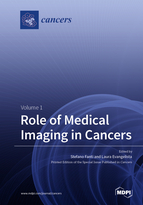Role of Medical Imaging in Cancers
A special issue of Cancers (ISSN 2072-6694).
Deadline for manuscript submissions: closed (31 December 2019) | Viewed by 138712
Special Issue Editors
Interests: PET imaging; PET/CT; molecular imaging; radiopharmaceuticals; prostate cancer; PSMA
Special Issues, Collections and Topics in MDPI journals
Interests: PET/CT; molecular imaging; radiopharmaceuticals; prostate cancer; PET/MRI
Special Issues, Collections and Topics in MDPI journals
Special Issue Information
Dear Colleagues,
Medical imaging comprises a huge amount of imaging techniques, from ultrasound and computed tomography (CT) to molecular imaging comprising magnetic resonance imaging (MRI) and positron emission tomography (PET).
Molecular imaging allows for the remote, noninvasive sensing and measurement of cellular and molecular processes in living subjects. It provides a window into the biology of cancer from the sub-cellular level to the patient undergoing a new, experimental therapy. Conventional imaging, i.e. CT is critical to the management of patients with cancer, conversely, molecular imaging provides more relevant information, such as the early detection of changes with therapy, identification of patient-specific cellular and metabolic abnormalities, and other specific biological features that have a considerable impact on morbidity and mortality.
Molecular imaging has developed rapidly in the last years, particularly in the oncological field. The development of new hybrid scanners, like digital PET/CT, PET/MRI and SPECT/CT, has significantly improved the detection of tumors in all phases of disease (from the initial stages to the evaluation of the response to therapy). Moreover, the introduction of various radiopharmaceutical agents has opened new scenarios for the in vivo molecular characterization of cancer.
Unfortunately, the barriers associated with the regulatory organs limit the use of these new agents in clinical practice, although an increased amount of preclinical and first human results are now available, particularly for new targeted radiopharmaceuticals. This Special Issue will highlight the role of molecular imaging in cancer management, covering some important aspects by focalizing the attention of new discoveries for the big killers, like prostate cancer, lung cancer, breast cancer and colon cancer.
Prof. Stefano Fanti
Dr. Laura Evangelista
Guest Editors
Manuscript Submission Information
Manuscripts should be submitted online at www.mdpi.com by registering and logging in to this website. Once you are registered, click here to go to the submission form. Manuscripts can be submitted until the deadline. All submissions that pass pre-check are peer-reviewed. Accepted papers will be published continuously in the journal (as soon as accepted) and will be listed together on the special issue website. Research articles, review articles as well as short communications are invited. For planned papers, a title and short abstract (about 100 words) can be sent to the Editorial Office for announcement on this website.
Submitted manuscripts should not have been published previously, nor be under consideration for publication elsewhere (except conference proceedings papers). All manuscripts are thoroughly refereed through a single-blind peer-review process. A guide for authors and other relevant information for submission of manuscripts is available on the Instructions for Authors page. Cancers is an international peer-reviewed open access semimonthly journal published by MDPI.
Please visit the Instructions for Authors page before submitting a manuscript. The Article Processing Charge (APC) for publication in this open access journal is 2900 CHF (Swiss Francs). Submitted papers should be well formatted and use good English. Authors may use MDPI's English editing service prior to publication or during author revisions.
Keywords
- Molecular imaging
- PET/CT
- PET/MRI
- Radiopharmaceuticals
- Oncology
- Targeted therapy
- Immunotherapy
- Prognosis








